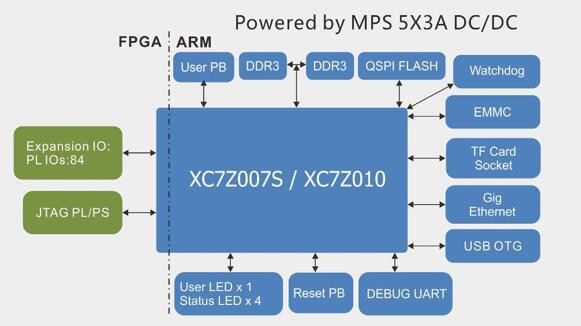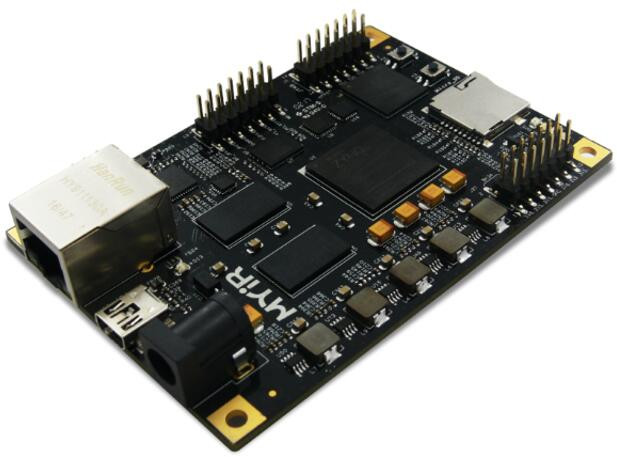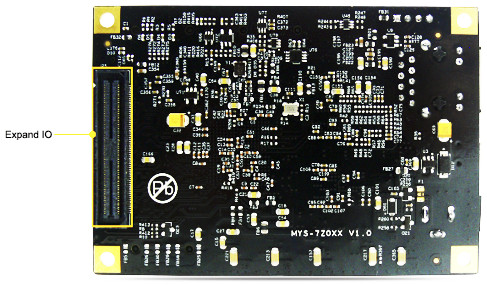Xilinx launched a cost down version of their Zynq-7000 series with Zynq-7000S series SoC combining a single ARM Cortex A9 core with Artix FPGA fabric last year. We’ve already seen sub 100 Euros/Dollars board based on the new SoCs with ZynqBerry and MiniZed boards. MYiR Tech has now launched their own version, a cost-down version of their Z-Turn board, with Z-Turn Lite board featuring either the new cost-down Zynq-7007S or the “good old” Zynq-7010 SoC.
- SoC
- Xilinx XC7Z007S-1CLG400C (Zynq-7007S) with a single ARM Cortex A9 core @ 667 MHz, Artix-7 FPGA fabric with with 23K logic cells, 14,400 LUTs, 66 DSP slices OR
- Xilinx XC7Z010-1CLG400C (Zynq-7010) with two ARM Cortex A9 cores @ 667 MHz, Artix-7 FPGA fabric with 28K logic cells, 17,600 LUTs, 80 DSP slices.
- System Memory – 512 MB DDR3 SDRAM (2 x 256MB, 32-bit)
- Storage – 4GB eMMC flash, 16MB QSPI flash, and a micro SD slot
- Connectivity – 10/100/1000M Ethernet
- USB – 1x mini USB 2.0 OTG port
- Debugging – USB-UART debug interface, 14-pin JTAG interface
- User I/O –1x 0.5mm pitch 120-pin connector for expansion interface on the bottom of the board
- Sensors – 3-axis acceleration sensor and temperature sensor
- Misc – 2x buttons (reset and user), boot selection jumpers, 5x LEDs, 1x Buzzer
- Power – 5V/2A via power barrel
- Dimensions – 91 x 63 mm (10-layer PCB design)
Compare to Z-Turn, Z-Turn Lite comes with less memory (512MB vs 1GB), adds a 4GB eMMC flash, and removed HDMI, CAN bus, and motion / temperature sensors, and only comes with one expansion interface instead to two. Z-Turn Lite board runs Linux 3.15.0, and the company provides all drivers with source code, Sourcery GCC 6.1 toolchain, and a ramdisk image. Potential target applications include Zynq-7000S series evaluation, multi-axis motor control, machine vision, programmable logic controller (PLC), industrial automation, and test & measurement.
 Z-Turn Lite board will start shipping on August 11st, but the company is already taking pre-order for $69 for the Zynq-Z7007S version, and $75 with Zynq-7010, including a 4GB SD card and product disk with documentation and source code. Alternatively, you can also get more complete kit with power supply, and cables for $89 and up. You’ll find purchase link and some hardware documentation like the PDF schematics on the product page.
Z-Turn Lite board will start shipping on August 11st, but the company is already taking pre-order for $69 for the Zynq-Z7007S version, and $75 with Zynq-7010, including a 4GB SD card and product disk with documentation and source code. Alternatively, you can also get more complete kit with power supply, and cables for $89 and up. You’ll find purchase link and some hardware documentation like the PDF schematics on the product page.

Jean-Luc started CNX Software in 2010 as a part-time endeavor, before quitting his job as a software engineering manager, and starting to write daily news, and reviews full time later in 2011.
Support CNX Software! Donate via cryptocurrencies, become a Patron on Patreon, or purchase goods on Amazon or Aliexpress






